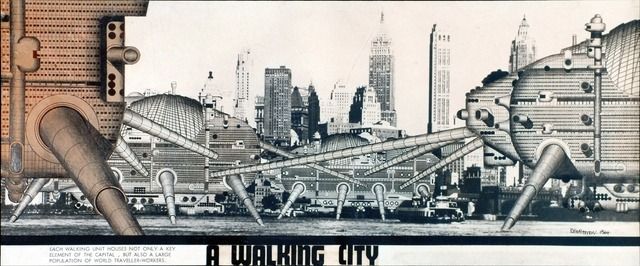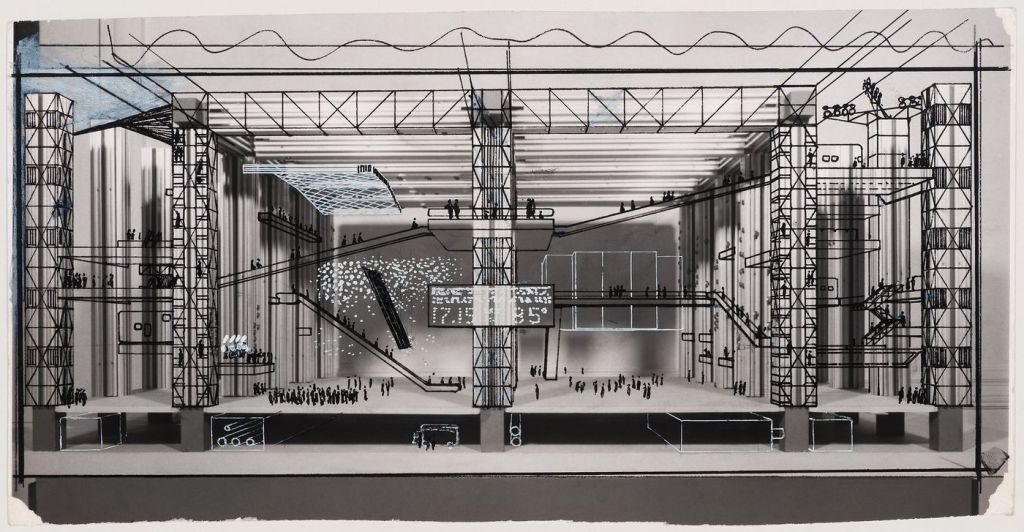The Pompidou Center Paris: Simulating Space

The Centre National d’Arts et de Culture George Pompidou or The Beauborg opened in 1977 designed by Renzo Piano and Richard Rogers with Ove Arup Engineers. Located in the center of Paris within 1km of the Louvre and Notre Dame Cathedral, it lies on the edge of the historic Marais quarter.
Introduction
It Neighbours Les Halles one of the old Parisian indoor markets now demolished and replaced by the shopping center Forum des Halles itself partially demolished and rebuilt in 2018. Les Halles was previously one of the locations of the May ’68 uprisings. The authorities wanted to provide much needed cultural services and bring these as close to the people as possible. They also wanted to reinstitute a cultural relevance and importance for Paris in the fine arts that they felt had been lost to New York.
It was to embody the new pluralist cultural policies of the French state after Georges Pompidou became President. An Academic, he took over from General de Gaulle and took the project under his wing. It is a litmus test, therefore, for the way Architecture relates to culture as it is a building dedicated to bringing that culture to the people of Paris and it’s visitors.
Design
An international competition was held and an unheard of pair of Architects won, Richard Rogers and Renzo Piano. It was what the brief asked for and then some taking the idea of bringing culture to the people as far as they could.
We changed the meaning from (I think it was called) ‘building for culture’ , to a ’building for information, culture, and entertainment,
- Richard Rogers quoted in Domus no. 566 1977 Jan pp1-37
The design dedicates a large public space in front of the building as a public square, really the first one in the center of Paris. The building itself was to be six floors of uninterrupted space 48m by 166m. There were to be no internal walls. The spaces inside could be changed completely according to the requirements of whatever could go on in there. The exhibition programme literally became the interior.
The central design philosophy was for a live centre of information. The design tried;
to be more like a department store in which everyone felt free to enter and move around: There should be a total and unimpeded interaction between the building and ‘quartier’, between the street , the plaza, the foyer’
- Rigby, Brian Popular Culture in Modern France p.186
Furthermore it was the archetypal hi-tech temple, structurally expressive, and given symbolic expression in the way in which the mechanical services were treated. It therefore, not only in the program, but in expression, straddles the modern and post-modern era. The statement of architectural concept published in Jury Report described particularly the;
two long facades, one facing West across a sunken square and the other facing Rue de Renar. A three - dimensional load-bearing wall carries constantly changing information, news what’s on in Paris, art works, traffic situations, maps, weather reports, cinema, television robots, temporary structures, electronic two - way games and information etc.
Influences
The building probably owes most to Ron Herron and Archigram whose walking city project 1964-66 happened just during the time Rogers and Piano came back to London. But Walking City didn’t appear out of a vacuum. It was part of a continuum of fun palaces or peoples cultural houses. Just it now had a technological spin.

Ron Herron and Archigram Walking City (1964-66)
Cedric Price and Joan Littlewood already five years earlier than Archigram had proposed the Fun Palace in 1961. A mega building that was never really finished, that was adaptable externally and flexible internally, and any traditional cultural institution or function could be accommodated within. Sound familiar?

Fun Palace By Cedric Price and Joan Littlewood (1961)
Neither idea was particularly new the Volkshaus (peoples house), mixed use cultural and social space housed under one roof, had been a tradition in the German labour movement. Indeed even before the Pompidou was finished in 1977 in 1976 the Palast der Republik (Palace of the Republic) was finished din East Germany on the site of the former Hohenzollern palace on the bank of the River Spree next to Museumsinsel.

Palast der Republik East Berlin
The Design by Heinz Graffunder and Karl-Ernst Swora contained two large auditoria, art galleries, theatre, restaurants, bowling alley and a discothèque.
The development of this model reaches this Apotheosis in Continuous Monument: An Architectural Model for Total Urbanization by Superstudio in which the a plain grid expanded to cover whole cities. There is only a meditated space that is programmed to have the correct required qualities, no shelter is needed, no buildings are required Architecture and the city are practically destroyed.

Continuous Monument: An Architectural Model for Total Urbanization
Design
The French President died just as the building of the Pompidou center that would carry his name began, it ran into problems almost immediately. The Services that were external and exposed had to be protected, the information wall was too expensive.
The East and West facades are conceptually symmetrically transparent making the space and layout of the building understandable, but the West facade, the main facade of circulating people is radically different from the East Facade which became less and less transparent as the need to protect the mechanical systems and ductwork increased. The information wall was never realised in anything like its original form and the buildings schematic concept is finally destroyed by a fire wall dividing the building in two.
For all its shortcomings however, it is a bold physical statement as building and intention. It appears to be a rejection of the state’s ideology which it represents. This is an illusion as Mollard (1st Secretary General of the Beaubourg in his book L’Enjeu du Centre Pompidou, Paris 10/18, 1976 points out. According to him it had learned from the cultural upheaval of 1968 and was the state’s attempt to capture the idea of a non-elitist Culture.
There exists another more all-embracing notion of Culture…..according to this definition, culture is the totality of those representations, values, actions, modes and rules which controls the mentality and the life style of the social group.
- Gaudibert, Action Culturelle : integration et / ou Subversion (1972) pp165-166
The French State wanted a non-elitist modern museum, democratic and open to all. Furthermore the building would take part in the city, in everyday life.

Criticism
The Pompidou center as we saw comes from a long line of technological attempts at revolutionising ideas of space, architectural vehicles for simulation.
The architecture of tomorrow will be a means of modifying present conceptions of time and space. It will be a means of knowledge and a means of action.
- Ivan Cntcheblov, Formulary for a New Urbanism, in Ken Knabb, Ed, Situationist International Anthology.
So perhaps the main charge against the Beaubourg is that it had seeded its spatial control to the idea of flexibility. The space can represent anything it’s by definition not Architectural, not made but represented. The Beaubourg is an Architectural spectacle, the image of technology as much as the technology of image.
(T)he allocation of space of space to each user (is) a major logistical exercise and is the occasion for the invention of a new type of bureaucrat- the ‘programmer’
- Claude Mollard, L’Enjue du Centre Pompidou, (Paris) quoted by Alan Colquhoun, Plateau Beaubourg in Colquhuon pp110.
The experience is lived through technology. Action itself just a simulation on a screen. The building becomes simulation not just for events, but for the spatial experiences, and the preoccupations of the public that go to see them.
The Beauborg turned this trip towards architectural oblivion into an architectural style, a parody of architectural destruction there can be no more post-modernist building than the Beauborg.